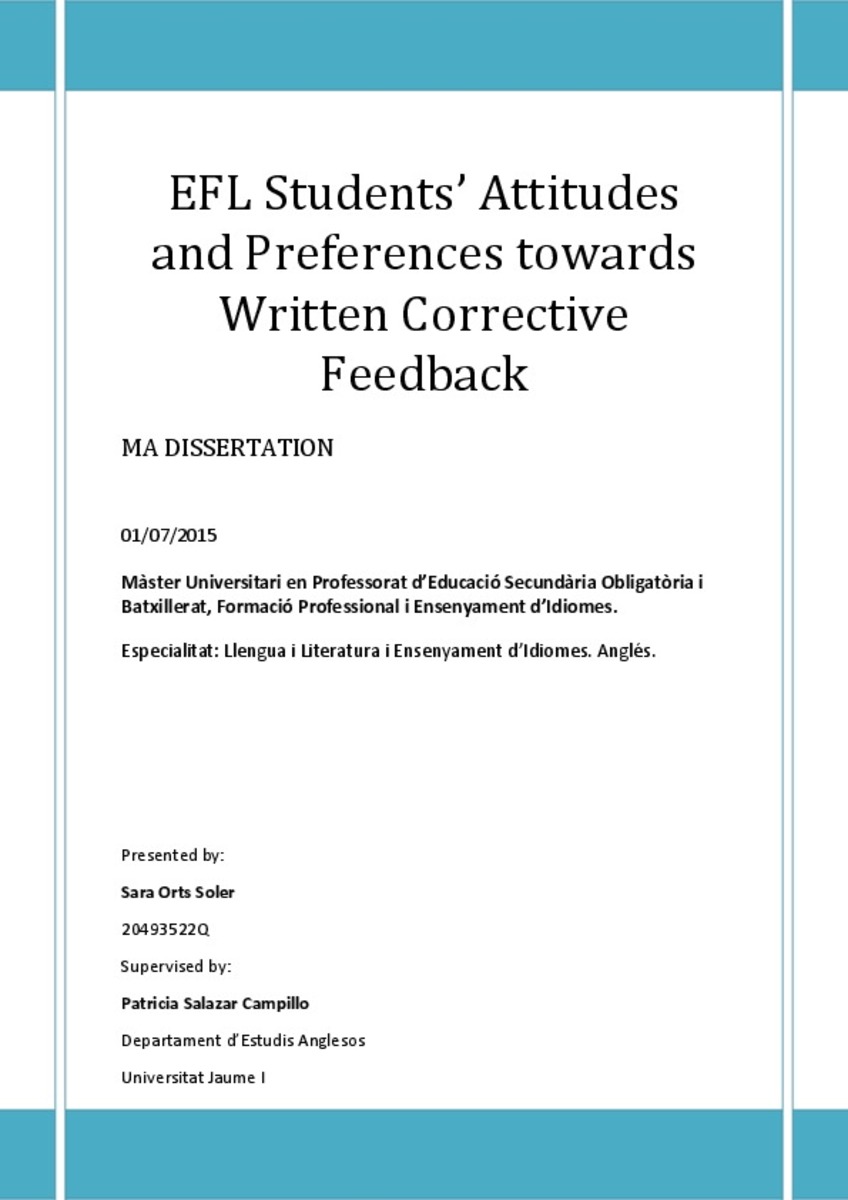Mostrar el registro sencillo del ítem
EFL students' attitudes and preferences towards written corrective feedback
| dc.contributor | Salazar Campillo, Patricia | |
| dc.contributor.author | Orts Soler, Sara | |
| dc.contributor.other | Universitat Jaume I. Departament d'Estudis Anglesos | |
| dc.date.accessioned | 2015-10-01T09:58:00Z | |
| dc.date.available | 2015-10-01T09:58:00Z | |
| dc.date.issued | 2015 | |
| dc.identifier.uri | http://hdl.handle.net/10234/134705 | |
| dc.description | Treball Final de Màster Universitari en Professor/a d'Educació Secundària Obligatòria i Batxillerat, Formació Professional i Ensenyaments d'Idiomes. Codi: SAP129. Curs: 2014/2015 | ca_CA |
| dc.description.abstract | Knowing students’ attitudes towards a new language can be very useful for language teachers. If the techniques used to correct errors do not meet students’ preferences, subsequent negative attitudes may emerge. This is why teachers should take into consideration students’ preferences for being corrected (Hyland, 2003). Many studies centre on the effect of feedback on students’ writing, but they omit learners’ attitudes and preferences towards corrective feedback (Katayama, 2007). Needless to say, not all students have the same preferences when it comes to written correction. For this reason, a study was carried out (Modalitat 2) to analyse students’ attitudes and preferences towards written correction and to determine age and English proficiency level as possible factors affecting such attitudes and preferences. The main results of the present study point to a greater preference for having all errors corrected in older students. However, younger students feel more motivated when they are corrected, consider making errors more positive and are more willing to accept correction by a classmate. In addition, older students give more importance to content and grammar, whereas younger learners concede similar importance to content, grammar, organization and vocabulary. Results according to level of proficiency show that B2 students feel more motivated to go on learning with correction. The higher the students’ English level, the greater their preference for self-correction. Finally, students with a low level of English consider that errors not affecting the understanding of the message should not be corrected. In conclusion, age and proficiency level are variables which affect these attitudes and preferences, but other learners’ variables would have an impact on them as well. | ca_CA |
| dc.format.mimetype | application/pdf | ca_CA |
| dc.language.iso | eng | ca_CA |
| dc.publisher | Universitat Jaume I | ca_CA |
| dc.rights | Attribution-NonCommercial-ShareAlike 4.0 Spain | * |
| dc.rights.uri | http://creativecommons.org/licenses/by-nc-sa/4.0/ | * |
| dc.subject | Màster Universitari en Professor/a d'Educació Secundària Obligatòria i Batxillerat, Formació Professional i Ensenyaments d'Idiomes | ca_CA |
| dc.subject | Máster Universitario en Profesor/a de Educación Secundaria Obligatoria y Bachillerato, Formación Profesional y Enseñanzas de Idiomas | ca_CA |
| dc.subject | Master's Degree in Secondary Education, Vocational Training and Language Teaching | ca_CA |
| dc.subject | Escritura | ca_CA |
| dc.subject | Enseñanza de la escritura | ca_CA |
| dc.subject | Enseñanza de lenguas | ca_CA |
| dc.subject.lcsh | Writing | ca_CA |
| dc.subject.other | Escriptura | ca_CA |
| dc.subject.other | Llenguatge i llengües | ca_CA |
| dc.subject.other | Llengua segona | ca_CA |
| dc.title | EFL students' attitudes and preferences towards written corrective feedback | ca_CA |
| dc.type | info:eu-repo/semantics/masterThesis | ca_CA |
| dc.educationLevel | Estudios de Postgrado | ca_CA |
| dc.rights.accessRights | info:eu-repo/semantics/openAccess | ca_CA |
Ficheros en el ítem
Este ítem aparece en la(s) siguiente(s) colección(ones)
-
TFM: Màster Universitari en Professor/a d'Educació Secundària Obligatòria i Batxillerat, Formació Professional i Ensenyaments d'Idiomes [1230]
SAP118, SAP119, SAP128, SAP129, SAP138, SAP139, SAP218, SAP219, SAP228,SAP229, SAP238, SAP239, SAP319, SAP419, SAP429, SAP509, SAP909, SAP709, SAP809








